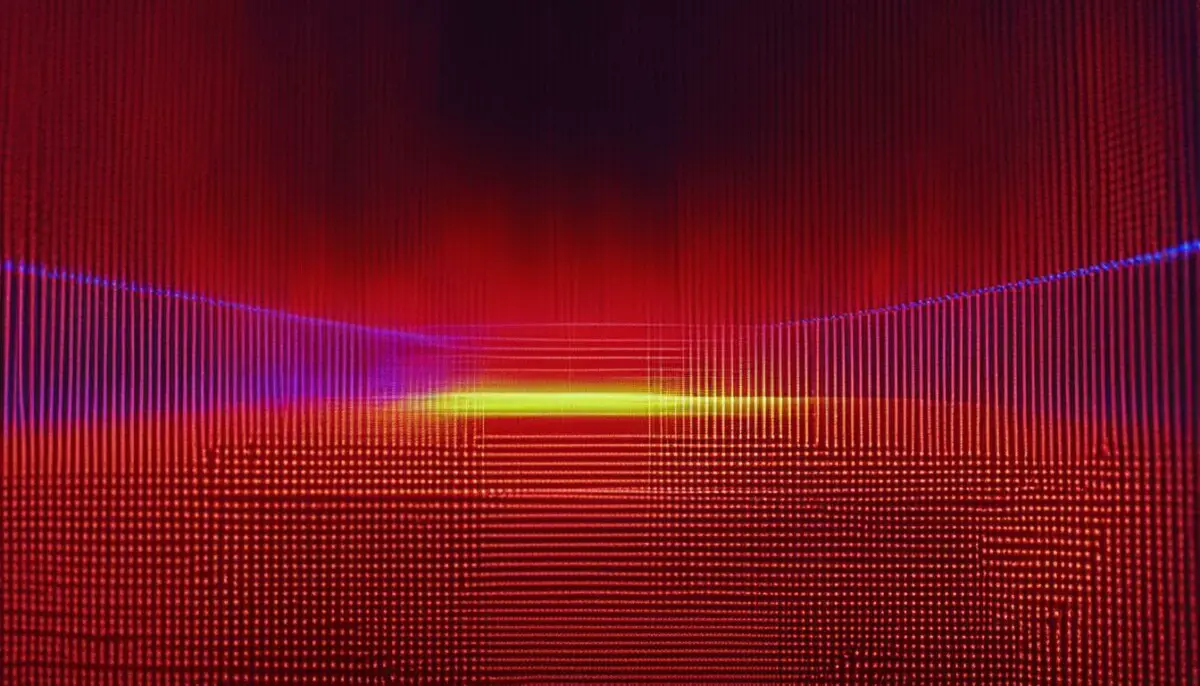Last Updated on 5 months by Francis
Welcome to our article where we explore the fascinating world of infrared lasers and thermal imaging. If you’re curious to know whether an infrared laser can be detected using thermal imaging technology, you’ve come to the right place. We’ll delve into the intricacies of how thermal cameras work, the basics of infrared lasers, and whether thermal cameras can detect their presence. So, let’s dive in and discover the hidden world of invisible light!
Contents
Key Takeaways:
- Thermal imaging technology detects heat emitted by objects using a microbolometer sensor.
- Infrared lasers emit light outside the range of human vision.
- Thermal cameras can indirectly detect infrared lasers by observing temperature changes.
- The effectiveness of detecting infrared lasers depends on factors such as laser power, wavelength, distance, and thermal camera sensitivity.
- Thermal imaging has a wide range of applications, from military operations to industrial inspections and home security.
Understanding Thermal Imaging Technology

Thermal imaging technology is a fascinating and versatile tool that allows us to visualize and analyze heat, also known as thermal energy or infrared radiation. Unlike traditional imaging techniques that rely on visible light, thermal imaging cameras detect and measure the infrared radiation emitted by objects. This technology is based on the use of a unique sensor called a microbolometer, which is capable of detecting even the tiniest differences in temperature.
The data collected by the microbolometer is then translated into a visual representation known as a thermogram. In a thermogram, different colors or shades are used to represent varying temperatures, allowing the user to quickly identify and analyze heat patterns and anomalies. This visual representation provides valuable insights into the distribution and intensity of infrared radiation, helping us understand the thermal characteristics of the objects and environments being observed.
Thermal imaging technology finds applications in a wide range of fields, including industrial inspections, law enforcement, and even medical diagnostics. It can be used to detect heat leakage in buildings, identify electrical malfunctions, locate missing persons in search and rescue operations, and even diagnose certain medical conditions. By harnessing the power of infrared radiation, thermal imaging technology has revolutionized the way we perceive and analyze heat, opening up a world of possibilities for various industries and sectors.
Advancements in Thermal Imaging Technology
Over the years, there have been significant advancements in thermal imaging technology, leading to improved performance and capabilities. Researchers and engineers are constantly striving to enhance the sensitivity, resolution, and accuracy of thermal cameras, making them even more effective in detecting and analyzing temperature variations caused by infrared radiation sources. These advancements have not only increased the overall quality of thermal images but also expanded the scope of applications for this technology.
One area of particular focus is the development of more compact and portable thermal cameras, allowing for greater ease of use in various environments. Additionally, there are ongoing efforts to enhance the real-time processing capabilities of thermal imaging devices, enabling faster and more accurate analysis of thermal data. The integration of advanced algorithms and machine learning techniques also holds great promise in further improving the performance and functionality of thermal cameras.
The future of thermal imaging technology looks promising, with continued efforts to enhance its capabilities and applications. As we gain a better understanding of the principles behind thermal imaging and continue to push the boundaries of technological innovation, we can expect even more exciting advancements in this field. Whether it’s for industrial inspections, security purposes, or scientific research, thermal imaging technology will continue to play a vital role in our modern world.
The Basics of Infrared Lasers
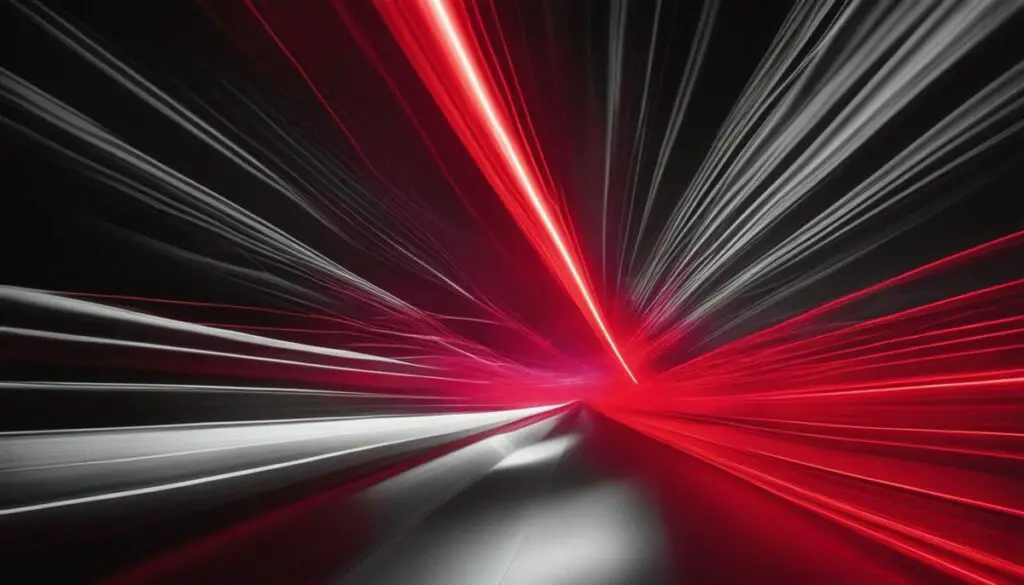
Infrared lasers are powerful tools that emit light in the infrared spectrum, which falls outside the range of human vision. Unlike visible light lasers, which produce beams that are visible to the naked eye, infrared lasers emit light that is invisible to us. This unique property makes them highly versatile and suitable for a wide range of applications.
In addition to their invisibility, infrared lasers have other distinct properties. They produce a narrow and focused beam of light, allowing for precise targeting and control. This makes them ideal for applications such as communication, measurement, and even weaponry. The concentrated beam of an infrared laser can be directed over long distances with minimal dispersion, making it highly effective in various scenarios.
Furthermore, unlike visible light lasers, the narrow, focused beam of an infrared laser does not emit heat in the same way as the objects it illuminates. This means that the laser beam itself does not cause significant temperature changes in the surrounding environment. Instead, the heat generated by an infrared laser is primarily due to the objects being illuminated by the laser. This property further enhances the safety and effectiveness of infrared lasers.
The unique properties of infrared lasers include:
- Invisibility to the human eye
- Narrow and focused beam
- Precise targeting and control
- No significant heat emission from the laser beam itself
These characteristics make infrared lasers invaluable in a wide range of applications, from scientific research to industrial processes and beyond. Their ability to emit invisible light with precision and power opens up new possibilities in various fields.
Can Thermal Cameras Detect Infrared Lasers?
Thermal cameras are widely used in various industries for their ability to detect and analyze heat signatures. However, when it comes to detecting infrared lasers, their capabilities are limited. While thermal cameras can indirectly detect the presence of an infrared laser by observing temperature changes in the surrounding objects, they cannot directly visualize the laser beam itself.
Unlike visible light lasers, which emit heat when illuminating objects, infrared lasers emit a narrow, focused stream of light that does not produce significant heat. This lack of heat emission makes it challenging for thermal cameras to directly visualize the laser beam. Instead, they rely on detecting the heat generated by the objects illuminated by the laser.
To understand why thermal cameras cannot visualize infrared lasers, it’s important to note that these cameras primarily focus on detecting and analyzing heat, not narrow beams of light. Their sensors, known as microbolometers, are designed to detect infrared radiation emitted by objects based on their temperature. While the heat generated by an object illuminated by an infrared laser can be detected, the actual laser beam itself remains invisible to the thermal camera.
Factors Affecting Infrared Laser Detection
Several factors influence the effectiveness of detecting infrared lasers using thermal cameras. The power and wavelength of the laser play a significant role, as higher-powered lasers with shorter wavelengths are more likely to generate detectable heat in the surrounding objects. The distance between the laser and the objects being illuminated also affects detection, as the heat dissipates with distance.
Furthermore, the sensitivity of the thermal camera itself plays a crucial role in detecting infrared lasers. Higher sensitivity allows the camera to detect smaller temperature variations, increasing the chances of indirectly detecting the laser’s presence. However, even with the most sensitive thermal cameras, direct visualization of the laser beam remains challenging.
Table: Factors Affecting Infrared Laser Detection
| Factors | Description |
|---|---|
| Power and Wavelength | Higher-powered lasers with shorter wavelengths are more likely to generate detectable heat in surrounding objects. |
| Distance | The farther the laser is from the objects being illuminated, the more the heat dissipates, reducing detection capabilities. |
| Thermal Camera Sensitivity | Higher sensitivity allows the camera to detect smaller temperature variations, increasing the chances of detecting the laser’s presence. |
Factors Affecting Infrared Laser Detection
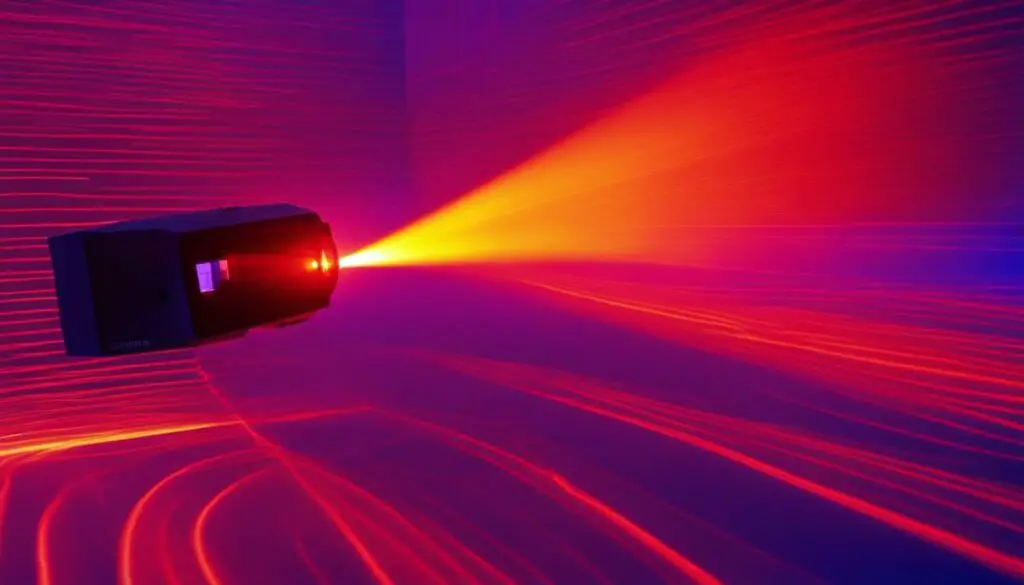
When it comes to detecting infrared lasers using thermal imaging technology, several factors come into play. These factors can affect the effectiveness and reliability of the detection process. Understanding these variables is crucial for accurately assessing the capabilities of thermal cameras in detecting infrared lasers.
Power and Wavelength
The power and wavelength of the infrared laser are significant factors that influence its detectability. Higher-powered lasers may produce more noticeable temperature changes in the surrounding objects, making them easier to detect. Similarly, lasers with shorter wavelengths can generate more intense heat, making their presence more apparent to thermal cameras.
Distance
The distance between the infrared laser and the object being illuminated is another critical factor. As the laser beam travels further, it tends to disperse and lose intensity. This dispersion can lead to smaller temperature changes in the surrounding objects, which may make detection more challenging for thermal cameras. It’s important to consider the range limitations of both the laser and the thermal camera when assessing their compatibility.
Thermal Camera Sensitivity
The sensitivity of the thermal camera itself plays a crucial role in detecting infrared lasers. Higher sensitivity cameras can detect smaller temperature variations, making them more effective at detecting the heat generated by the laser. It’s important to choose a thermal camera with the appropriate sensitivity level for the specific application and desired detection capabilities.
| Factor | Effect on Infrared Laser Detection |
|---|---|
| Power and Wavelength | Higher power and shorter wavelength increase detectability. |
| Distance | Greater distance may decrease detectability due to beam dispersion. |
| Thermal Camera Sensitivity | Higher sensitivity improves the detection of temperature changes. |
By considering the power and wavelength of the infrared laser, the distance between the laser and the object, and the sensitivity of the thermal camera, one can make informed decisions regarding the detection of infrared lasers. These variables should be carefully evaluated to ensure optimal performance and accurate results when using thermal imaging technology.
Applications of Thermal Imaging Technology
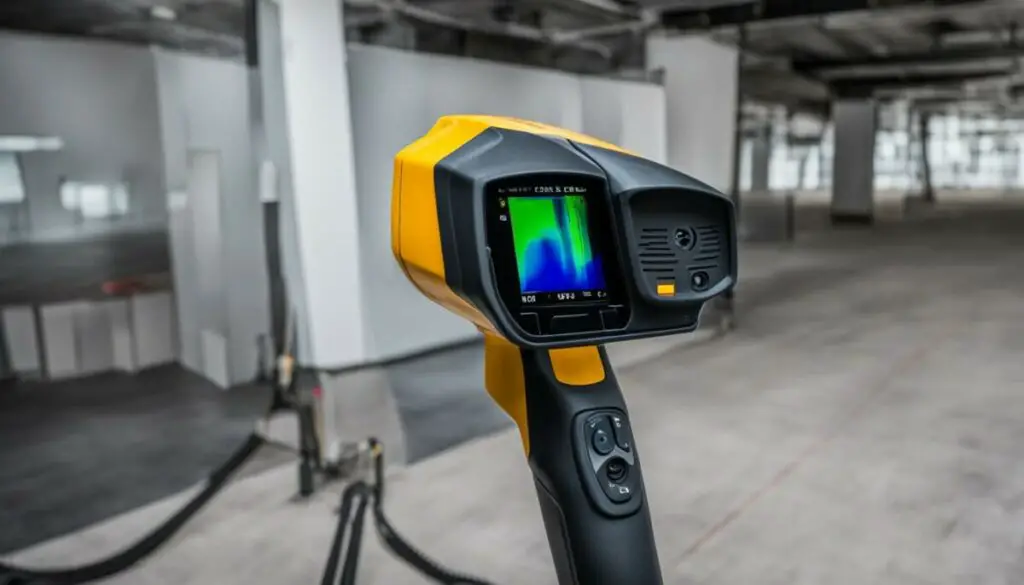
Thermal imaging technology has become invaluable in a variety of fields, including military operations, law enforcement, industrial inspections, and home security. Its ability to detect heat signatures and identify temperature variations makes it a versatile tool for various applications. Let’s explore some of the key areas where thermal imaging is making a difference:
Military
In the military, thermal imaging is used for reconnaissance and surveillance. It allows soldiers to detect and track enemy movements, even in low-light or obscured conditions. By identifying heat signatures, thermal cameras provide crucial information on the presence of potential threats and help ensure the safety of troops in the field.
Law Enforcement
Thermal imaging technology is also widely utilized by law enforcement agencies. It aids in search and rescue missions by enabling officers to locate missing persons or suspects, even in challenging environments. Thermal cameras can detect hidden individuals, identify hotspots in building fires, and help track fleeing suspects by following their heat signatures.
Industrial Inspections
In industrial settings, thermal imaging is used to identify faulty equipment, detect energy inefficiencies, and prevent potential hazards. By visualizing temperature variations, thermal cameras can pinpoint overheating machinery, electrical malfunctions, or insulation issues, allowing for timely maintenance and preventing costly breakdowns.
Home Security
Thermal imaging technology has made its way into the residential sector as well. It provides an extra layer of security by detecting intruders, even in the dark. Thermal cameras can identify individuals based on their heat signatures, alerting homeowners to potential threats and facilitating a rapid response from law enforcement.
Overall, thermal imaging technology has revolutionized these industries by providing enhanced situational awareness, improved safety, and efficient troubleshooting. As advancements continue, we can expect further applications of this technology in various other sectors, cementing its role as a crucial tool in a wide range of fields.
| Industry | Applications |
|---|---|
| Military | Reconnaissance, surveillance, tracking |
| Law Enforcement | Search and rescue, suspect tracking, firefighting |
| Industrial | Machinery inspection, energy efficiency, safety |
| Home Security | Intruder detection, perimeter monitoring |
Limitations of Thermal Imaging for Laser Detection
While thermal cameras can indirectly detect the presence of an infrared laser by observing temperature changes in the surroundings, they have limitations when it comes to directly visualizing the laser beam itself. This is because the laser beam does not emit heat in the same way as the objects it illuminates. Thermal imaging technology primarily focuses on detecting and analyzing heat signatures, rather than the visualization of narrow, focused beams of light.
“Thermal imaging cameras are highly effective in detecting the heat generated by objects illuminated by infrared lasers,” says Dr. Maria Thompson, a thermal imaging expert. “However, they cannot directly visualize the laser beam due to its lack of heat emission. This limitation should be considered when evaluating the capabilities of thermal cameras for laser detection.”
Another limitation of thermal cameras for laser detection is the distance factor. As the laser beam dissipates over a distance, its temperature changes become less significant and more difficult to detect. The effectiveness of the thermal camera in detecting the laser beam decreases as the distance between the laser and the object increases.
Furthermore, the capabilities of the thermal camera itself play a crucial role in laser detection. The sensitivity of the camera’s microbolometer determines its ability to detect small temperature changes and accurately identify the presence of an infrared laser. Higher sensitivity cameras can detect lower temperature differences, resulting in improved laser detection capabilities.
Table: Limitations of Thermal Imaging for Laser Detection
| Limitations | Explanation |
|---|---|
| Lack of Laser Beam Visualization | Thermal cameras cannot directly visualize the narrow, focused laser beam due to its negligible heat emission. |
| Distance Factor | As the laser beam dissipates over distance, its temperature changes become less significant and harder to detect. |
| Camera Sensitivity | The sensitivity of the thermal camera’s microbolometer determines its ability to detect small temperature changes and accurately identify the presence of an infrared laser. |
Despite these limitations, thermal imaging technology remains a valuable tool for detecting heat signatures and indirectly identifying the presence of infrared lasers. Ongoing advancements in thermal imaging technology aim to enhance the sensitivity and precision of thermal cameras, further improving their capabilities in detecting and analyzing temperature variations caused by infrared lasers.
Advancements in Thermal Imaging Technology
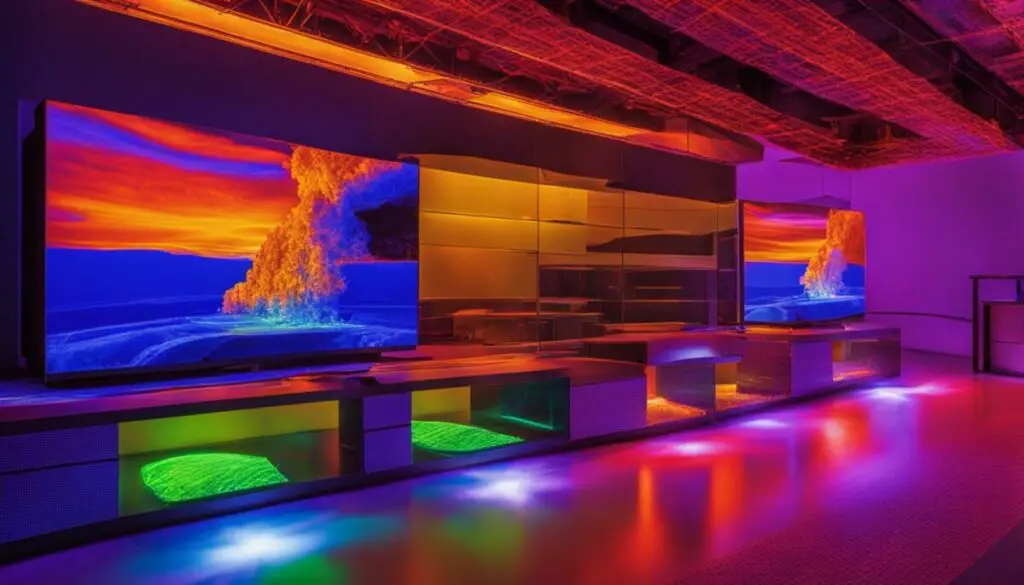
As technology continues to advance, the field of thermal imaging is constantly evolving, leading to significant advancements in the detection and analysis of infrared radiation. These advancements have greatly enhanced the capabilities of thermal cameras, making them increasingly effective in detecting and analyzing temperature variations caused by infrared lasers.
One area of advancement lies in the sensitivity of thermal cameras. Improvements in sensor technology have enabled thermal cameras to detect even the subtlest changes in temperature, allowing for more accurate detection of infrared laser presence. This enhanced sensitivity is crucial in applications where precise detection and analysis are essential, such as military operations or industrial inspections.
Another notable advancement is the increased resolution of thermal images. Higher resolution cameras provide clearer and more detailed images, allowing for better visualization and analysis of temperature variations. This enables operators to identify infrared laser hotspots more accurately, leading to more effective decision making and response.
Furthermore, advancements in image processing algorithms have significantly improved the analysis capabilities of thermal cameras. These algorithms can now detect and track infrared laser movement, making it easier to identify and analyze laser patterns. This level of analysis provides valuable insights into the behavior and characteristics of infrared lasers, aiding in the development of countermeasures and improved laser detection systems.
| Advancement | Description |
|---|---|
| Enhanced Sensitivity | Improved sensor technology allows for more accurate detection of infrared laser presence. |
| Increased Resolution | Higher resolution cameras provide clearer and more detailed images for better visualization and analysis. |
| Advanced Image Processing | Algorithms can detect and track infrared laser movement, enabling better analysis of laser patterns. |
A Comparison between Thermal Imaging and Night Vision
Thermal imaging and night vision are two distinct technologies used for imaging in low-light or dark environments. While both technologies serve a similar purpose, they differ in terms of their detection and recognition capabilities.
Thermal imaging excels at detecting heat signatures and identifying anomalies in the form of varying temperatures. It operates by detecting the infrared radiation emitted by objects and converting it into a thermogram, where different colors or shades represent different temperatures. This makes thermal imaging particularly useful for applications such as military and law enforcement operations, industrial inspections, and home security. However, thermal imaging does not provide detailed object recognition.
On the other hand, night vision technology relies on capturing available light, such as moonlight or ambient lighting, and amplifying it to create a visible image. This allows for better object recognition and identification in low-light conditions, making night vision suitable for activities like navigation, surveillance, and wildlife observation. Night vision devices can provide clearer details and enhanced visual clarity compared to thermal imaging. However, they are less effective in detecting heat signatures or temperature variations.
| Thermal Imaging | Night Vision | |
|---|---|---|
| Detection | Excels at detecting heat signatures and temperature variations. | Limited detection capabilities, relies on available light. |
| Recognition | Does not provide detailed object recognition. | Allows for better object recognition in low-light conditions. |
| Environmental Adaptability | Works well in various environments and lighting conditions. | Relies on external light sources, limited effectiveness in complete darkness or extreme conditions. |
| Price | Thermal imaging devices are generally more expensive. | Night vision devices are generally more affordable. |
In summary, the choice between thermal imaging and night vision depends on the specific requirements and environmental conditions. Thermal imaging is ideal for detecting heat signatures and anomalies, while night vision excels at object recognition in low-light situations. Understanding the strengths and limitations of each technology is essential in determining the most suitable imaging solution for different applications.
Comparing Thermal Imaging and Night Vision Devices
When it comes to choosing between thermal imaging and night vision devices, several factors need to be considered. These include price, environmental conditions, lighting situation, and the specific requirements for detection and recognition. Let’s take a closer look at each of these factors.
Price
The cost is an important consideration when deciding between thermal imaging and night vision devices. Generally, night vision devices are more affordable compared to thermal imaging devices. Therefore, if budget is a significant concern, night vision devices may be the more economical choice.
Environmental Conditions
The environmental conditions in which the devices will be used are crucial factors to consider. Night vision relies on visible light to produce images, which means it may not perform optimally in extreme darkness or foggy conditions. On the other hand, thermal imaging does not rely on light and can operate effectively in various environmental conditions, making it a more versatile option.
Lighting Situation
Consider the lighting situation in the intended application area. Night vision devices excel in scenarios with some available light, such as in urban environments or under a moonlit sky. Thermal imaging, however, does not require any light sources and can provide reliable detection capabilities even in complete darkness. Therefore, if the application requires detection in low-light or no-light situations, thermal imaging is the preferred choice.
Detection vs. Recognition
Finally, the specific requirements for detection or recognition play a crucial role in choosing between thermal imaging and night vision. Thermal imaging is primarily used for detection, identifying heat signatures and detecting temperature variations. On the other hand, night vision is more suitable for object recognition and identification, allowing for more detailed visuals. Consider the intended use case and prioritize whether detection or recognition is more important for your needs.
| Thermal Imaging | Night Vision | |
|---|---|---|
| Price | Higher | Lower |
| Environmental Conditions | Works well in various conditions | Dependent on lighting conditions |
| Lighting Situation | Can operate in complete darkness | Requires some available light |
| Detection Capabilities | Identifies heat signatures and temperature variations | Allows for object recognition and identification |
The Future of Thermal Imaging for Infrared Laser Detection
Advancements in technology continue to shape the future of thermal imaging, particularly in its application for detecting and analyzing infrared lasers. Ongoing research and development efforts aim to enhance the sensitivity, resolution, and capabilities of thermal cameras, making them even more effective in identifying temperature variations caused by infrared laser illumination.
These advancements in thermal imaging technology have the potential to greatly improve the detection of infrared lasers, enabling a more comprehensive understanding of their presence and impact. With improved sensitivity, thermal cameras can detect even faint temperature changes caused by lower-power infrared lasers, expanding their range of detection capabilities.
Furthermore, advancements in resolution allow for more precise analysis of temperature variations, enabling better localization and characterization of infrared laser-illuminated objects. This enhanced level of detail can provide valuable insights for a range of applications, including military operations, law enforcement, industrial inspections, and home security.
| Advancements | Benefits |
|---|---|
| Improved sensitivity | Enhanced detection of temperature changes caused by infrared lasers |
| Higher resolution | Precise analysis and localization of infrared laser-illuminated objects |
| Expanded range of detection capabilities | Detection of lower-power infrared lasers |
As technology continues to evolve, we can expect future thermal imaging devices to be even more effective in detecting and analyzing infrared lasers. These advancements in thermal imaging technology will contribute to improved security, safety, and efficiency across various industries, paving the way for new applications and possibilities.
The future of thermal imaging for infrared laser detection is promising, with ongoing advancements driving improvements in technology and capabilities. These advancements will further enhance the ability to detect, analyze, and understand infrared laser presence, opening up new opportunities and applications for thermal imaging in a wide range of industries and fields.
Conclusion
In conclusion, thermal cameras may not directly visualize infrared laser beams, but they play a crucial role in indirectly detecting their presence. By observing temperature changes in the surrounding objects, thermal imaging technology provides valuable insights into the general area where an infrared laser is being directed. This capability makes thermal cameras an important tool in applications such as military operations, law enforcement, industrial inspections, and home security.
As technology continues to advance, it is expected that further improvements will be made in the field of thermal imaging. Ongoing research and development aim to enhance the sensitivity, resolution, and capabilities of thermal cameras, enabling them to detect and analyze various sources of infrared radiation with even greater accuracy. These advancements will undoubtedly contribute to the overall effectiveness of thermal imaging in detecting and analyzing temperature variations caused by infrared lasers.
In summary, while thermal cameras may not provide a direct visualization of infrared laser beams, their ability to indirectly detect these lasers through temperature changes makes them a valuable asset. As the technology progresses, thermal imaging will continue to evolve and expand its capabilities in detecting and analyzing infrared radiation. Ultimately, this progress will contribute to improved safety, security, and efficiency in a wide range of fields where thermal imaging is applied.
FAQ
Can thermal imaging cameras directly visualize infrared laser beams?
No, thermal imaging cameras cannot directly visualize infrared laser beams. They can indirectly detect their presence by observing temperature changes in the surrounding objects.
How do thermal imaging cameras detect heat?
Thermal imaging cameras detect heat by utilizing a sensor called a microbolometer to measure the infrared radiation emitted by objects.
What are infrared lasers and how do they differ from visible light lasers?
Infrared lasers are lasers that emit light in the infrared spectrum, which falls outside the range of human vision. Unlike visible light lasers, the narrow, focused beam of an infrared laser does not emit heat in the same way as the objects it illuminates.
Can thermal cameras detect the presence of infrared lasers?
Yes, thermal cameras can detect the presence of infrared lasers by observing temperature changes in the surrounding objects. However, they cannot directly visualize the laser beam itself.
What factors can affect the effectiveness of infrared laser detection using thermal cameras?
Factors such as the power and wavelength of the laser, the distance between the laser and the object, and the sensitivity of the thermal camera can all impact the effectiveness of infrared laser detection.
What are some applications of thermal imaging technology?
Thermal imaging technology is used in various applications, including military and law enforcement operations, industrial inspections, and home security. It can identify heat signatures, detect temperature variations, and locate potential threats or abnormalities in different environments.
What are the limitations of thermal imaging for laser detection?
The limitations of thermal imaging for laser detection arise from the fact that thermal cameras primarily focus on detecting and analyzing heat signatures rather than visualizing narrow, focused beams of light.
How is thermal imaging different from night vision?
Thermal imaging excels at detecting heat signatures and identifying anomalies, while night vision is more suitable for object recognition and identification in low-light or dark environments.
What factors should be considered when choosing between thermal imaging and night vision devices?
Price, environmental conditions, and lighting situations are important factors to consider when choosing between thermal imaging and night vision devices. Night vision relies on visible light, while thermal imaging does not require any light to operate.
What does the future hold for thermal imaging in infrared laser detection?
Ongoing advancements in thermal imaging technology aim to improve the detection and analysis of infrared laser presence. Research and development efforts focus on enhancing the sensitivity, resolution, and capabilities of thermal cameras.

